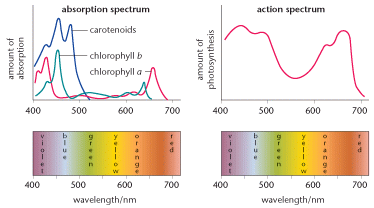Photosynthetic pigments
Chlorophyll is not just one substance. There are several different chlorophylls, e.g. chlorophyll a and chlorophyll b.
- Each is a molecule which has a hydrophilic head and hydrophobic tail.
- The head always contains a magnesium ion and plays a key part in the absorbing or harvesting of light.
- The hydrophobic tail anchors to the thylakoid membrane.
As well as the chlorophylls there are other accessory pigments, e.g. carotenoids which also absorb light energy. There are a range of photosynthetic pigments found in different species.
The graphs below show the specific wavelengths of light which are absorbed by a range of pigments. The data for the absorption spectrum was collected by measuring the absorbance of a range of different wavelengths of light by a solution of each pigment, chlorophyll a, chlorophyll b, and carotenoids, separately. Following this, plants were illuminated at each wavelength of light, in turn, to investigate the amount of photosynthesis achieved at each wavelength.
This data is shown in the action spectrum.

What can be learned from the graphs?
- Blue and red light are absorbed more, and so are key wavelengths for photosynthesis.
- Different pigments have different light absorptive properties.
- Groups of pigments in a chloroplast are therefore much better than just one as more energy can be harnessed for photosynthesis.
- The green part of the spectrum is not absorbed well; no wonder the plants look green as the light is reflected!
